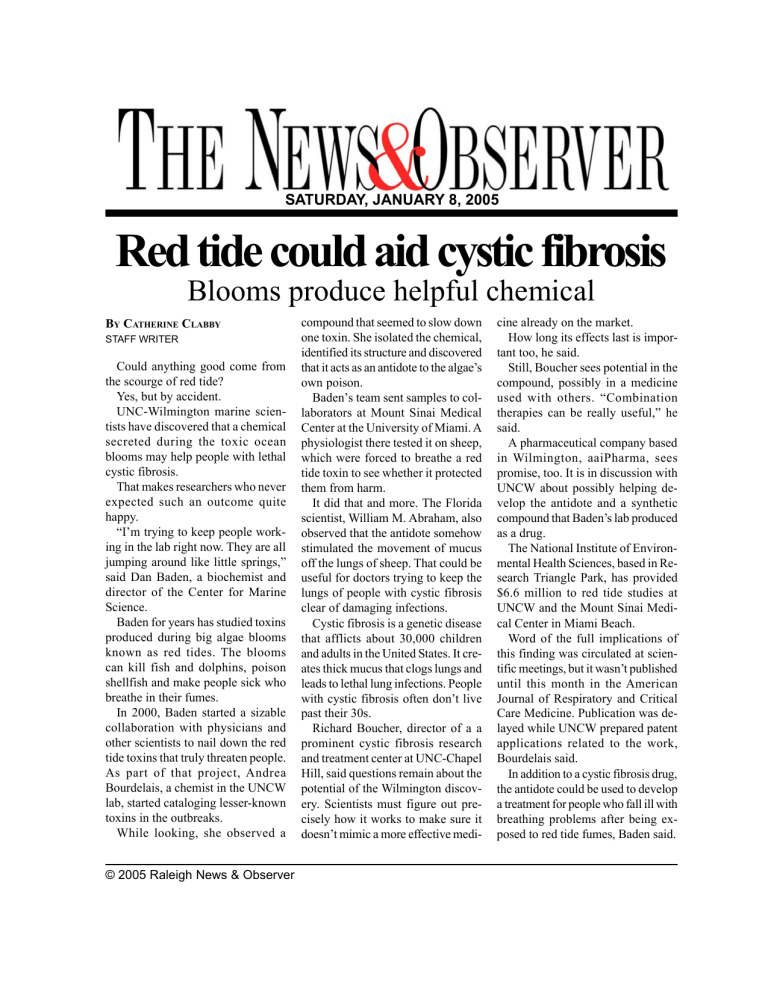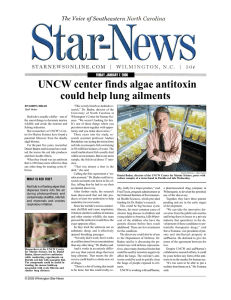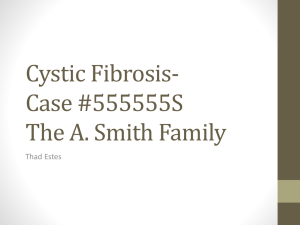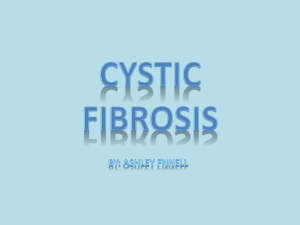B C compound that seemed to slow down cine already on the market.

SATURDAY, JANUARY 8, 2005
Red tide could aid cystic fibrosis
Blooms produce helpful chemical
B
Y
C
ATHERINE
C
LABBY
STAFF WRITER
Could anything good come from the scourge of red tide?
Yes, but by accident.
UNC-Wilmington marine scientists have discovered that a chemical secreted during the toxic ocean blooms may help people with lethal cystic fibrosis.
That makes researchers who never expected such an outcome quite happy.
“I’m trying to keep people working in the lab right now. They are all jumping around like little springs,” said Dan Baden, a biochemist and director of the Center for Marine
Science.
Baden for years has studied toxins produced during big algae blooms known as red tides. The blooms can kill fish and dolphins, poison shellfish and make people sick who breathe in their fumes.
In 2000, Baden started a sizable collaboration with physicians and other scientists to nail down the red tide toxins that truly threaten people.
As part of that project, Andrea
Bourdelais, a chemist in the UNCW lab, started cataloging lesser-known toxins in the outbreaks.
While looking, she observed a compound that seemed to slow down one toxin. She isolated the chemical, identified its structure and discovered that it acts as an antidote to the algae’s own poison.
Baden’s team sent samples to collaborators at Mount Sinai Medical
Center at the University of Miami. A physiologist there tested it on sheep, which were forced to breathe a red tide toxin to see whether it protected them from harm.
It did that and more. The Florida scientist, William M. Abraham, also observed that the antidote somehow stimulated the movement of mucus off the lungs of sheep. That could be useful for doctors trying to keep the lungs of people with cystic fibrosis clear of damaging infections.
Cystic fibrosis is a genetic disease that afflicts about 30,000 children and adults in the United States. It creates thick mucus that clogs lungs and leads to lethal lung infections. People with cystic fibrosis often don’t live past their 30s.
Richard Boucher, director of a a prominent cystic fibrosis research and treatment center at UNC-Chapel
Hill, said questions remain about the potential of the Wilmington discovery. Scientists must figure out precisely how it works to make sure it doesn’t mimic a more effective medicine already on the market.
How long its effects last is important too, he said.
Still, Boucher sees potential in the compound, possibly in a medicine used with others. “Combination therapies can be really useful,” he said.
A pharmaceutical company based in Wilmington, aaiPharma, sees promise, too. It is in discussion with
UNCW about possibly helping develop the antidote and a synthetic compound that Baden’s lab produced as a drug.
The National Institute of Environmental Health Sciences, based in Research Triangle Park, has provided
$6.6 million to red tide studies at
UNCW and the Mount Sinai Medical Center in Miami Beach.
Word of the full implications of this finding was circulated at scientific meetings, but it wasn’t published until this month in the American
Journal of Respiratory and Critical
Care Medicine. Publication was delayed while UNCW prepared patent applications related to the work,
Bourdelais said.
In addition to a cystic fibrosis drug, the antidote could be used to develop a treatment for people who fall ill with breathing problems after being exposed to red tide fumes, Baden said.
© 2005 Raleigh News & Observer




